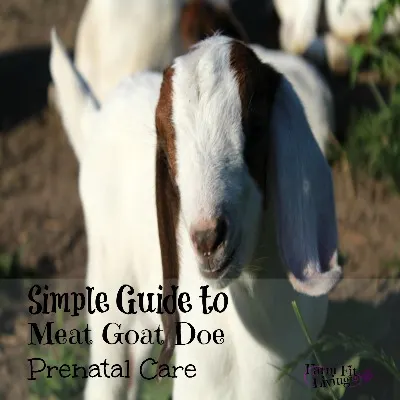Like human mommies, goat does need proper prenatal care and good nutrition to grow and deliver healthy babies.
Prenatal care for meat goat does is an important part of meat goat care.
As a responsible farmer, it is my duty to the animals so be sure they have the utmost care and nutrition available. They need plenty of protein, vitamins, and of course, all the water available.
I make sure my does have prenatal care a month before they are due to kid. The does have been on pasture and browse since spring. During that time, they have access to supplemental protein and mineral to keep their prime condition.
Our Breeding Protocol
A successful kidding season begins with good planning. I schedule all of our breedings five months before I want them to kid. I do this to make sure I’m going to be available to help them have their babies.
Kidding in the fall has been the most ideal time for me to be available to my does when they are kidding. However, it is difficult for meat goats to breed for Fall kids since it is not the natural rut period.
In order for the does to be bred in the summer months to kid in the fall, I have learned to synchronise them using natural hormones.
I synchronize a small group of 10 -12 does at a time by inserting CIDR’s. The CIDRs are left inside the does for 14 days. Then, a shot of PG600 is given and the CIDR is pulled 12 hours later.
Finally, the does immediately go into a pen with Clem for at least 30 days. It usually takes about 12 – 48 hours for the does to come into heat.
I have had great luck with this protocol. The main factor affecting my synchronizing procedure has been the weather. I have had one group through the years that have had a poor success rate for breeding in the summer using this protocol. I believe it was due to the constant heavy rains we experienced that month.
Once the does have been in with the buck for at least a month, they come out and a new group goes in. When all my does have been synchronized and exposed to the buck, I put the buck in with all the does for “clean up”. This is to ensure that all the does will be bred.
Clean up breeding occurs during natural rut, so no synchronization is used. I usually only have a few does to “clean up” that will kid after the first of the year.
Doe Prenatal Care
Fast forward five months. As scheduled kidding time approaches, I keep a sharp eye on the does as they mature.
I look for the size of their udders (bags) as well as the swelling of vulvas. These two major signs are noticeable in most does about 30 days out from kidding. Here are the five main signs I look for before kidding.
A month before kidding, they receive their prenatal shots. We give them a booster of CD-T, which protects them and their kids from Colostridial viruses and Enterotoxemia. They also receive a small dose of antibiotic to protect the babies from Chlamydia.
We also give them pedicures and de-worm them with Safeguard if they need it.
The group of does ready to kid is penned up separately in a large maternity pen. They get feed, hay, mineral, and special care. I like to make sure they are comfortable and calm during this time as they are nesting and preparing for labor.
The prenatal care we give our does are unique to our own operation.
Our goal is always healthy live kids. In order to achieve this goal, the does need to be in peak health as well.
Hopefully, our practice can help you know how to implement doe prenatal care before kidding season begins.
“What Supplies Do You Use During Kidding Season?”
~ Much Love ~



